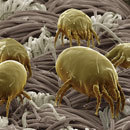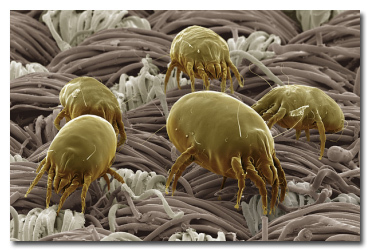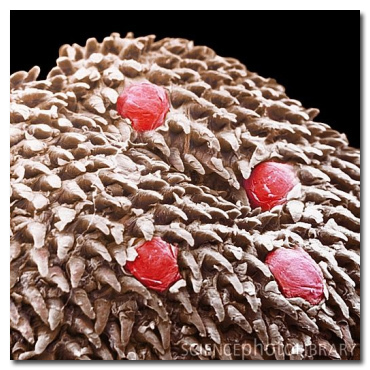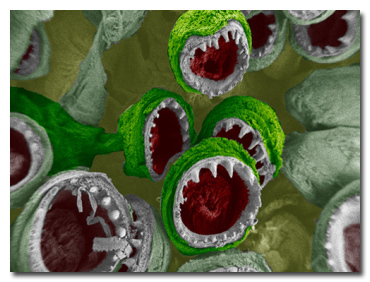11 Everyday Things That Are Terrifying Under a Microscope

As human beings, we go about our day-to-day lives, completely oblivious to the microscopic world around us. And that ignorance is great, because most of that microscopic world is scary as hell. Cracked has touched on some of these horrors before, but like the Leprechaun movies, the terror could not be confined to just one installment.
Your Pillow

At Normal Size:
Odds are there's at least one pillow lying on your bed right now, but here's a picture anyway:

Everyone on board so far?
You rest your head on one almost every night (excepting those instances where you wake up in a daze on bloodied tile/pavement with a racketeer's jawbone in your vest pocket). It is a place of warmth, comfort and security.
But Up Close ...
You couldn't be more wrong. This is your bedroom pillow this very second:

"We're just waiting for an ear to crawl into."
Those are common house dust mites. There's about a bajillion of these micro horrors living inside your pillow as we speak. We couldn't find a source saying that they crawl all over your face and into your ears and nose while you sleep, but really, do you trust them not to? They graze on your pillow like bloated alien cattle and feed off of your dead skin cells (and presumably your terror-soaked nightmares as well).
Hydrothermal Vent Worms

At Normal Size:
Hydrothermal vent worms are so tiny that you can't see them. They live around the hydrothermal vents on the abyssal plain of the ocean floor, which is probably another big reason you can't see them:

Oh, they're in there. Waiting.
But Up Close ...

Run, Kevin Bacon, run!
Upon closer inspection, the hydrothermal vent worm (or razorbeak vaginabeast, as we have just classified it, just now) leaves little doubt that the hydrothermal vent in question is a sulfur-belching portal to the plains of the damned. If you told us that this thing snatches the souls of children in the night and ferries them to the underworld, we wouldn't be surprised. Also, try to play it cool, but it's behind you.
Fortunately, its mouth is less than a millimeter wide, but rest assured -- if it could, that worm would devour everything you have ever loved.
Your Tongue

At Normal Size:
Your tongue is that thing sitting in your mouth right now:

You can't avoid touching it, and if you've ever made out with someone, you've been rubbing two of them together at the same time. Remember that.
But Up Close ...
Because they both look like this:

A pine cone with herpes.
The human tongue is covered in tiny spikes called filiform papillae. They do a variety of useful things, such as sensing pressure and helping to manipulate the food in your mouth, all while looking like the disease-ridden shingled back of some hollow mountain troll. And just imagine kissing someone, with all those spikes interlocking like a brown fleshy bike chain. Imagine it.

This is precisely what John Lennon was thinking about when he wrote that song.
Sex

At Normal Size:
The Internet contains the most extensive and specific visual library of sex in the known universe, so we really don't need to show you a picture. It is literally right at your fingertips if you absolutely cannot contain yourself.
But have you ever wondered what sex looks like at the cellular level? Actually, you probably haven't, so get ready:
But Up Close ...


Is that ... is it wearing a hat?
That writhing mass of blue tentacles is sperm, and the webbed purple moon sphere is the egg. Each looks relatively disgusting in its own right (the sperm looks like what would happen if aliens tried to make spaghetti with loose testicles for the meatballs), but that's nothing compared to the actual act of sex:

WHY DOES EVERYTHING HATE EVERYTHING?!
The magic of lovemaking at the microscopic level is less Barry White and more Omaha Beach. Granted, this is an image of in-vitro fertilization, mainly because science hasn't found a way to cram an electron microscope up a woman's uterus mid-coitus just yet. Still, the end result of a normal bout of naked-time tussling between two reasonably fertile individuals would look about the same. Then, of course, there is the chance of pregnancy, the miracle of life, the joining of two souls to create a third, which looks remarkably like the joining of dirty old deli cheese and a plastic straw:

Behold, the skeezy magic of creation.
Moths and Butterflies

At Normal Size:
Butterflies are the most adorable insects in the world. Their gossamer wings are beautifully painted like stained glass windows. Moths aren't nearly as pretty in general, but some, like the luna moth, are downright gorgeous.

They're like little haikus with wings.
But Up Close ...


We're seeing some similarities with the sperm closeup here.
Why, nature? Why would you give something so beautiful such a terrifying face? It's like the Fergie of the animal kingdom. Why does it have feathers on its face? And 5,000 eyes? What living creature benefits from having innumerable hideous, terrifying eyes stapled all over its head?
Their faces aren't even any cuter when they're babies, which is normally a rule of the animal kingdom. Here's what a caterpillar looks like up close:

"Good afternoon, I'm Putrid P. Scrotum, and I'd like to sell you some life insurance."
The Human Eye

At Normal Size:
When you meet someone for the first time, their eyes are one of the first things you notice -- and for good reason. We use them to express emotion and establish who we are speaking to, and to catalog suitable entries in our mental Encyclopedia Masturbatana:

#106, "Iron Eyes."
But Up Close ...

It looks like the blast wave of a cotton candy nuke.
This is a real photograph of a human eye, via electron microscope. The blue part is the pupil, and that twisted orange horror-custard is the iris. But from this angle, it looks like those dead elf marshes from The Lord of the Rings, or something Dante and Virgil had to row across to avoid winged sentries wielding brimstone spears forged from hatred.
Your Eyelashes

At Normal Size:
You see eyelashes pretty much as often as you see eyes. Heck, we even make wishes off of stray ones.

Eyelashes are basically just hair anyway, right? Surely there's no terrifying sight to behold here, how bad could hair possibly be?
But Up Close ...
It isn't the lashes so much as the tiny creatures that live inside them:

That itching sensation on the back of your neck is perfectly normal.
Those are called Demodex, and they're mites that live on everyone's eyelashes. They feed off of the dead skin cells and oil that collect in your follicles. Those are actually just the asses of several Demodex, which is a small portion of the whole beast:

Nature doesn't generally look so ... flaccid.
Demodex actually come out onto your face at night to breed, and then return to your follicles to lay up to 25 eggs. To repeat that for emphasis, they fuck on your face and lay eggs inside of you.
Solitary Bee Larva

At Normal Size:
A solitary bee is any bee species in which all females are fertile, so it covers a number of different bees, but all of their larvae look similar, sort of like cute pudgy worms:

"Maggotlike" might be more precise than "cute."
But Up Close ...

"I am always hiding under your blankets."
The existence of this is actually astounding because it proves two very important things: 1) There is a God and 2) God has a buddy who bet Him a ton of God-money that He couldn't make a creature entirely out of gray scrota.
Its face is shaped like a human skull, and it has tiny mouth-hands to drag you kicking and screaming into its gaping maw, which looks to contain a gateway to the endless eternal blackness of a starless galaxy of despair. But really, all the horror stems from its beady, soulless eyes, firing a hideous dead gaze that bores through your retinas and rips your mind in two. And then, it feeds. It feeds.
Dental Plaque

At Normal Size:
Plaque is that gunk that forms on your teeth when you don't brush and/or are British. And to be honest, it already looks pretty disgusting at normal size:

"Do you just, like, gargle coffee?"
But Up Close ...
Your dentist has probably told you that plaque contains a lot of bacteria, but dentists are awful and manipulative and untrustworthy. Cracked? Cracked is trustworthy. You listen to Cracked.

It's full of bacteria. Like, full. Plaque is 100 percent composed of bacteria and "bacterial products," which is the pleasant way of saying "bacteria poop." So you have a fine, pasty mixture of bacteria and shit on your teeth, and if you don't brush, it just builds and builds.

Eventually, it starts building societies.
It doesn't take long to build up into a thick layer of biofilm that coats your teeth like whitewash (brownwash?). As this video shows, eight hours is enough time for bacteria to spackle your pearlies with microscopic turds.
Aphids

At Normal Size:
Aphids look like little green watermelon seeds, and really aren't any more horrifying than the average insect. They congregate in large groups, but that's the scariest thing about them:

The ant is apparently crowd surfing.
But Up Close ...
Under an electron microscope, aphids look like high level dungeon beasts guarding the Throne of the Universe:

He's eating an ice cream cone made of his own face.
That completely scientific description isn't terribly far from the truth. Ants bend aphids to their whim, herding them like cattle and even milking them (you may recognize this sentence as the literal definition of insanity). It wouldn't be surprising to see aphids patrolling the halls outside of the queen ant's throne room, looking to rend unwary adventurers limb from limb.
Squid Suckers

At Normal Size:
Squids are essentially the birds of the ocean. They have beaks, they are formidable predators and there are species large enough to eat just about any damn thing in their environment.

If they could fly, we'd already be extinct.
As most people know, the tentacles of a squid are covered in suction cups, sort of like those Garfield dolls you can hang on your car window, only drenched in more primal terror. The suction cups don't look like much more than white dots to the naked eye, like sticky bits of poster-hanging glue.
But Up Close ...

It looks like a screengrab from some ad for heartburn medicine.
OK, this doesn't even look like a photograph. But it absolutely is. It won the 2008 International Science and Engineering Visualization Challenge in the "This Is Totally a Real Photo, I'm Not Even Lying" division. So in summation, squid tentacles are covered in hundreds of furious gnashing-fanged mouths, because nature didn't think carjackings and AIDS were scary enough.
For more from Kier, check out some of his other articles, or follow his mad ravings on Twitter.
For more nightmare fuel , check out The 5 Most Horrifying Bugs in the World and 14 Horrifying Soft Drinks Around the World.